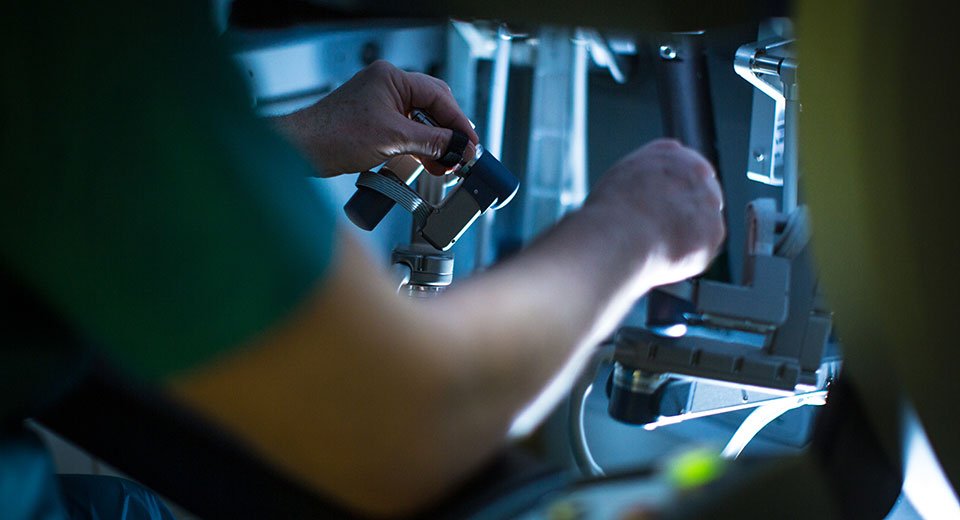Prostatectomy surgery with the help of a robot
Over 80 percent of prostatectomies in the U.S. are now done with robotic surgery, a procedure done using a system that has mechanical arms and surgical instruments directed by the surgeon.
“I would argue it’s almost standard of care for prostatectomy,” said Hyannis Urologist Bijan Salari, MD, who performs surgery at Cape Cod Hospital and Falmouth Hospital.
Last fall, the Hyannis hospital installed the new da Vinci® Xi robotic surgical system, which includes updated and more refined technology and precision, using smaller, more flexible instruments, and better camera technology that allows for better visualization than earlier versions, Dr. Salari said.
“It really is a focal point of surgery, including urologic surgery, because there are so many benefits to patients,” he said.
The major benefits to performing prostatectomies (removal of the prostate, usually due to the presence of cancer in the gland) and other surgeries with the da Vinci robotic system, according to Dr. Salari are:
- A shorter hospital stay. “It gives us the ability to send patients home usually within one day of surgery, whereas before they’re staying three to seven days,” he said.
- Fewer incisions and less pain. “It’s very beneficial from a pain standpoint, and less bleeding and complication standpoint,” he said.
- Less nerve damage. “It allows you to spare the nerves that maintain erection,” he said. “The robot allows you to be much more precise.”
The da Vinci system is about six feet tall with a console at which the surgeon sits and operates it near the bedside. The robot is ‘docked’ to the patient through tiny keyhole incisions, making any surgical procedure done with the system a minimally invasive one. The surgeon uses his or her hands and feet to control the robot and its delicate instruments.
The robotic system helps the surgeon, who is viewing the surgical field through a camera view box, see 360 degrees around while inside the patient, without needing to make new incisions or adjustments to the system while the patient is under anesthesia. Because of its ability to rotate completely around, the da Vinci can be brought to the patient at any angle without having to undock it from the patient. If the best angle for surgery is with the patient’s head down, the robot’s arms automatically adjust so what the surgeon is looking at inside the body does not change.
“With the new robot, we have the ability to more efficiently dock to the patient because of the greater mobility of the arms, which helps speed up that aspect of things,” said Dr. Salari, whose practice is located at Greater Boston Urology on Attucks Lane in Hyannis. “You can dock to the patient in multiple different angles, because of the flexibility of the arms. It really does make for a smoother procedure without disruptions and just faster and more efficient, in general.”
Dr. Salari, who trained on a robotic system during his medical residency, is enthusiastic about the new system at CCH because it offers the surgeon so much more precision and flexibility, which means the patient usually has a better experience, as well.
“Specifically, the ability to have almost a 360-degree movement of the arms allows you to do technical and complicated suturing that a lot of times would be very difficult to do in an open surgery or even a laparoscopic surgery,” he said. “Just the mobility of the arms and the precise way they move, relative to how we control, it is better.”
The da Vinci system would not be recommended if the patient had too much scar tissue from multiple abdominal surgeries. In that case, the surgeon typically needs more exposure to the abdominal region, he said
Other Cape Cod Healthcare-affiliated urologic surgeons who are skilled on the da Vinci system are Brian Kowal, MD; Robert Hartnett, MD, FACS; and Jose Reyes, MD, FACS.
In addition to prostatectomies, the da Vinci system is being used for pyeloplasty surgery, which is done when there is a blockage in the tube that drains urine from the kidney to the bladder. The surgeon removes the blocked area and reconnects the tube to the kidney. When an open surgery is done, it requires a 6-7-inch or larger incision, but just three tiny incisions are made using the da Vinci robot, Dr. Salari said. The result is less pain and a hospital stay that is typically several days shorter than with the open procedure, he said.
